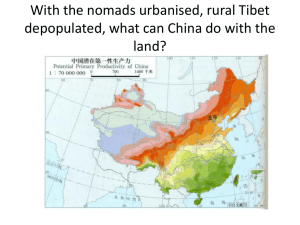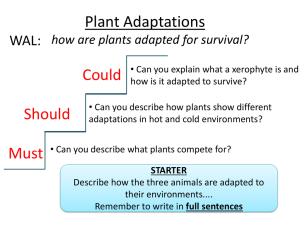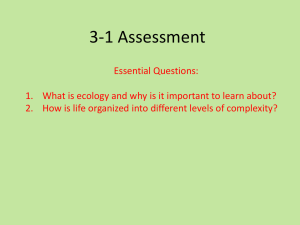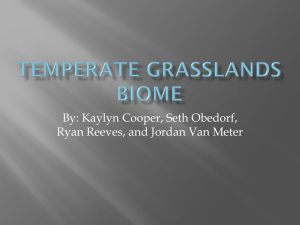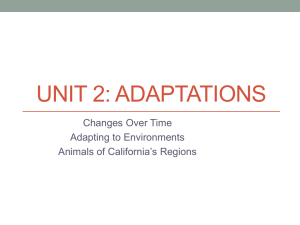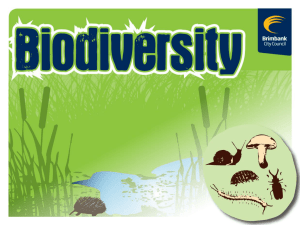Habitats and Adaptations
advertisement
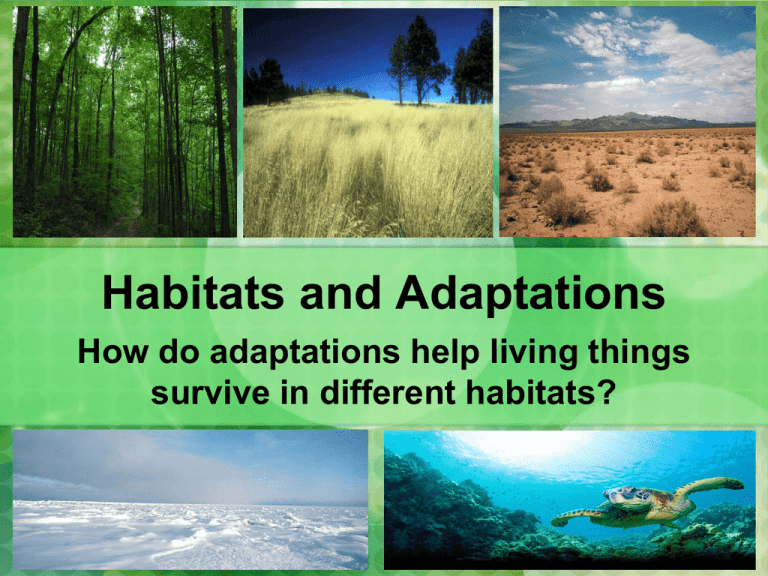
Habitats and Adaptations How do adaptations help living things survive in different habitats? http://www.youtube.com/watch?v=ZgKw7Ne_MA0 Life in the Desert Objectives Explain that a desert habitat has a dry climate and dry, sandy soil. Explain that desert plants and animals have specific adaptations to help them survive. Desert Vocabulary Some desert animals can hide in plain sight. Their body coverings blend in with the environment. Blending in is an adaption called camouflage. It helps animals stay safe. Rattlesnakes and coyotes, among others, are nocturnal. This means they sleep during the day. They come out at night when it is cooler. A desert is a habitat that has a dry climate. Less than 10 inches of rain falls in the desert each year. Temperature and Soil Temperature in the desert is very different between day and night. During the day, the Sun’s heat warms the land and air. The desert is much cooler at night than in the day. The soil in a desert is mostly sand. There is little humus to soak up rainwater. http://www.youtube.com/watch?v=E-E5jd4brXU What adaptations help desert plants? Some plants can grow in deserts. Other plants cannot. Plants that grow in deserts have adaptations that help them survive with little water. Special Roots: help take in water Special Leaves and Stems: help store water Spines and Thorns: protect them from thirsty animals What adaptations help desert animals? Sleeping the Day Away Keeping Cool Rattlesnakes and coyotes are nocturnal. They come out at night when it is cooler. Large ears and thin bodies help animals such as the desert jackrabbit stay cool. Blending In Some desert animals can hide in plain sight. Their body coverings blend in with the environment. Camouflage helps animals stay safe. http://www.youtube.com/watch?v=7Ifk9IJl0A0 Desert Lesson Review 1. Main Idea: What adaptations help desert plants and animals survive? 2. 3. Vocabulary: What is a desert like? Describe it. Critical Thinking: Buffalo have thick, dark coats. They eat mainly grasses. Could a buffalo survive in a desert? Explain your answer. 4. Test Prep: Deserts are habitats with… A. B. C. D. Cold climate and frozen soil Wet climate and marshy soil Dry climate and sandy soil Hot climate with lots of rainfall http://www.youtube.com/watch?v=-nohuNF4j7c Life in the Grasslands Objectives Explain characteristics of temperate and tropical grassland habitats. Identify structures that enable plants and animals to help them survive in grasslands. Grassland Vocabulary Burrows- holes some animals dig in the ground to hide. Grassland- habitat covered by grasses. Herds- groups of animals that stay together for safety. Prairies- grasslands of North America. Savanna- grasslands of the Serengeti Plain. Temperate- environment with a mild climate that has four seasons. Tropical- environment that has a warm climate yearround because it is near the equator. What is a grassland? Grass is everything to a grassland. Grass is food for animals. Grass is both a hiding place and a shelter from the wind and cold. Grass holds down soil that would otherwise blow away in the wind. http://www.youtube.com/watch?v=kFIMWyo8P_4 A fox uses the grass to hide. Grasshoppers have back legs built for jumping. Two Types of Grasslands Temperate Grassland Means the environment has a mild climate and four seasons. Have soil that is rich in humus. Tropical Grassland Means the environment is near the equator and is warm all year round. Have a rainy season and a dry season. Have more trees and poorer soil. http://www.youtube.com/watch?v=Tuk-JW-wng0 What adaptations help grassland plants survive? Deep roots that work like a sponge. Deep roots can survive Fire may burn the grass above the soil, but deep roots are not harmed. This means grass can grow back quickly after a fire. fires. Only grow leaves during wet season. Fire resistant bark. Thick trunk to store water. Baobab trees have bark that resists fire. What adaptations help animals survive in grasslands? Many kinds of animals live in grasslands. All of them have adaptations that help them survive. Flat Teeth Animals have adapted for eating grass. Burrows Small animals can hide easily. Speed Animals running fast to catch prey. Zebras bite grass easily with their flat teeth. Prairie dogs can escape danger quickly by hiding in burrows. Cheetahs have flexible spines that help them run fast. Grasslands Lesson Review 1. Main Idea: What are grasslands? 2. Vocabulary: What word describes grasslands that are warm year-round? 3. Compare & Contrast: How are grasslands and deserts alike? How are they different? 4. Test Prep: Where are Tropical grasslands found? A. near the North Pole B. near the equator C. in North America D. in Antarctica Life in the Forest Objectives Describe different types of forest environments. Identify adaptations of forest organisms. Forest Vocabulary 1. 2. 3. 4. 5. 6. 7. 8. Buttresses- these support a tall tree with shallow roots. Camouflage- this allows an animal to blend in with its environment. Coniferous- this type of tree has tough needles that help it to conserve water during winter. Deciduous- this type of tree loses its leaves in fall so it can conserve energy in water. Drip tips- these help leaves lose extra rainwater. Forest- this habitat has many trees. Hibernate- this is what squirrels do when they sleep all winter to store energy. Mimicry- this is when a mantis is able to look like an orchid flower. What is a forest? A forest is a habitat that has many trees Tropical Rain Forest • Found near the equator • Have more kinds of living things than any other land habitat • hot and wet • About 200 to 460 centimeters of rain falls here in a single year • Temperature stays between 68 degrees and 93 degrees all year • Soil is not very rich in plant nutrients What is a forest? A forest is a habitat that has many trees Temperate Forest • Has four seasons (winter, spring, summer, and fall) • Temperatures and rainfall change from season to season • Winters are cold and dry • Summers are warm and wet • About 76 to 127 centimeters of rain fall each year • Soil is rich with humus The Rain Forest The forest’s tallest trees reach the emergent layer. Tree branches and leaves form the canopy. Smaller trees and plants grow in the understory. This layer does not get much light. The forest floor is dark and damp. Forest Adaptations- Plants Tropical Rainforest Trees grow very tall and have shallow roots Leaves have drip tips to lose extra water Plants of forest floor have large leaves to soak up the very little sunlight that gets to them Forest Adaptations- Plants Temperate Forest Deciduous trees- lose leaves in fall Coniferous trees-make cones instead of flowers Temperate Coniferous Trees Forest Adaptations- Animals Tropical Rainforest Colors warn that a plant or animal could be poisonous Mimicry is when one living thing imitates another living thing in color or shape The poison arrow frog’s bright colors warn predators to stay away Mimicry helps this orchid mantis stay safe An iguana’s long tail helps it balance in the high branches of the tropical rain forest Forest Adaptations- Animals Temperate Forest: these animals have adaptations that help them survive the changing seasons and to keep them safe. Eat extra food in fall to store energy for winter Grow thicker coats in winter Hibernate- go into a deep sleep that lasts through winter Dormice hibernate during winter A porcupine’s sharp quills help it stay safe Skunks spray a smelly chemical to keep predators away Forest Lesson Review 1. 2. 3. 4. Main Idea: How are tropical rain forests different from temperate forests? In what ways are these two types of forests similar? Vocabulary: What is mimicry? Main Idea and Details: What adaptations help plants and animals survive cold winters in a temperature forest? Test Prep: All of the following are layers of the rain forest EXECPT… a. emergent b. submergent c. canopy d. understory
